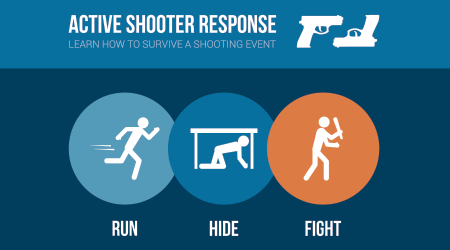Navigating the Unthinkable: Active shooter Safety and the “Run, Hide, Fight” Protocol
In an era where headlines are often marred by tragic incidents of violence, it’s essential to confront the reality of active shooter situations with preparedness and awareness. With each occurrence, the urgency to understand and implement effective safety measures grows more pressing. Among the most widely recognized strategies is the “Run, Hide, Fight” protocol, a simple yet potentially life-saving approach to navigating the chaos of an active shooter scenario.
Understanding the Threat
The term “active shooter” refers to an individual engaged in killing or attempting to kill people in a confined and populated area, typically through the use of firearms. These events unfold rapidly and unpredictably, leaving little time for hesitation or indecision. Understanding the nature of such threats is the first step toward preparedness.
Run
“Run” is the primary directive in the “Run, Hide, Fight” protocol. When gunfire erupts, the instinctual response for many is to flee the danger zone. This instinct should be followed, as swift evacuation drastically increases the chances of survival. However, it’s crucial to run with purpose and direction, seeking to put as much distance as possible between oneself and the threat.
In the midst of panic, maintaining a sense of situational awareness is key. Take note of emergency exits, evacuation routes, and potential obstacles that may impede escape. Avoid congregating in large groups or bottlenecks, as these areas can become targets for shooters. Instead, prioritize personal safety and encourage others to do the same.
Hide
If escape is not immediately possible, the next course of action is to “hide.” Seek shelter in a secure location, preferably one that can be locked or barricaded from the inside. Turn off lights, silence electronic devices, and remain as quiet as possible to avoid drawing attention to your whereabouts.
When choosing a hiding place, consider factors such as visibility, accessibility, and potential avenues of escape. Barricade doors with heavy objects or furniture if available and prepare to defend your position if necessary. Keep in mind that the goal of hiding is to remain concealed until it is safe to evacuate or until help arrives.
Fight
As a last resort, individuals may find themselves compelled to “fight” back against an active shooter. This option should only be considered when escape and hiding are not viable options, and when confronted with imminent danger. Fighting should be undertaken with the utmost determination and aggression, using any available means to incapacitate the assailant and neutralize the threat.
In the absence of weapons, improvised tools and objects can be used as makeshift weapons to defend oneself and others. Remember that the goal is not to engage in a prolonged confrontation, but rather to create an opportunity to escape or seek assistance. Coordination and cooperation with others in confronting the attacker can significantly increase the chances of success.
Preparedness and Training
Effective response to an active shooter situation requires more than just awareness—it demands preparation and training. Organizations and individuals alike should prioritize education and drills to familiarize themselves with the “Run, Hide, Fight” protocol and other safety measures. Regularly review emergency plans, conduct simulations, and engage in active dialogue about threat recognition and response strategies.
Additionally, fostering a culture of vigilance and mutual support within communities can enhance overall resilience to potential threats. Encourage open communication, reporting of suspicious behavior, and collaboration in developing proactive security measures.
Conclusion
While the prospect of an active shooter incident is undoubtedly alarming, adopting a proactive and informed approach to safety can mitigate risks and save lives. The “Run, Hide, Fight” protocol serves as a valuable framework for guiding individual and collective response in the face of danger. By prioritizing preparation, awareness, and decisive action, we empower ourselves and others to navigate the unthinkable with courage and resilience.
National Protective Services, Inc. is here to help. With more than 40 years’ experience, NPS has the insight and tools necessary to reduce crime in your neighborhood or workplace. We offer a free on-site consultation. Contact us today and find out how it feels to have NPS officers protecting you like family.

